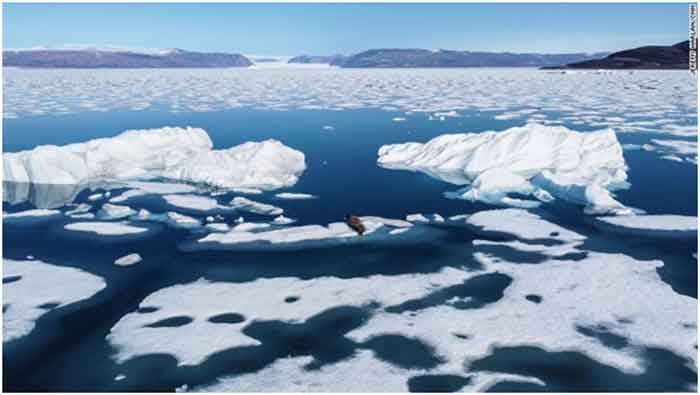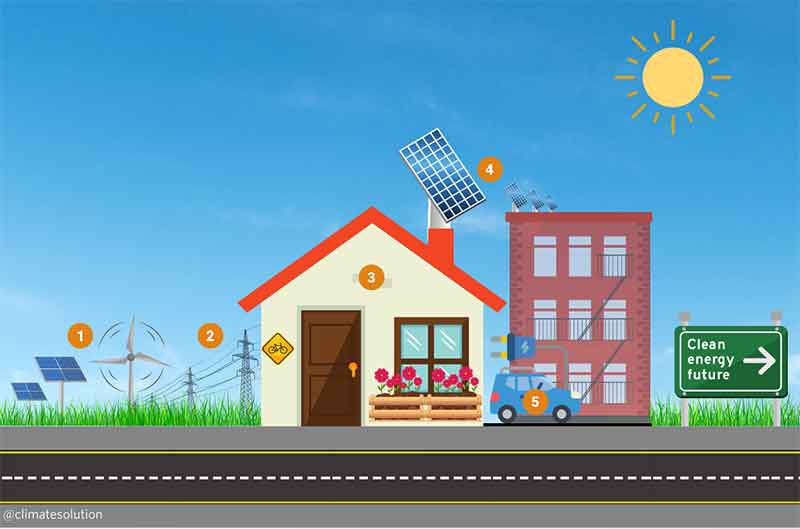
Anybody who closely follows global warming knows that the Arctic has been clobbered 2-3 times beyond the impact on the planet. And knowledgeable sources also know that what happens in the Arctic doesn’t stay in the Arctic. After all, for millennia Arctic ice steadfastly served as the planet’s numero uno biggest reflector of solar radiation by reflecting 80%-90% of sunlight back to outer space.
But what if the ice is gone?
Where does all the heat go?
It’s a problem that threatens life as we know it. Alongside nuclear war, it’s one of the bigger threats to civilization since back in time when humans huddled together around smoldering fires in damp, darkened caves.
Based upon scientific studies, including the fact that the following are already in motion, the impact of an iceless Arctic: (1) Disruption of the jet streams in the troposphere at 20,000-30,000 feet which, in turn, throws off normal weather patterns throughout the Northern Hemisphere, as the steady westerlies don’t know which way is up or down or stalled, causing flash floods, torrential rains, scorching droughts, and brutal cold snaps seldom witnessed before, bringing forth unpredictable conditions with extreme cycles that whiplash society, e.g. last year’s 2022-primer for 2023-24 (2) Amplifies Greenland’s disintegration, which is already showing signs of considerable weakness and frailty as 24 feet of sea level rise remains tenuously trapped in ice. Scientists, such as Dr. Jason Box, Geological Survey of Denmark and Greenland, have already put Greenland on special alert status (3) Accelerated melting of permafrost across Siberia, Alaska and Canada where thermokarst lakes by the thousands, yes, by the thousands, are popping up almost overnight, spewing methane bubbles, according to Dr. Katey Walter Anthony, Aquatic Ecosystem Ecologist and professor, University of Alaska. Alas, methane is much more powerful at stimulating global warming than CO2.
Unfortunately, an iceless Arctic is totally misunderstood by people in leadership roles. There are many naïve leaders when it comes to the science and the consequential impact of an iceless Arctic, like former Secretary of State Mike Pompeo (Looking North: Sharpening America’s Arctic Focus speech, Rovaniemi, Finland, May 2019) celebrating the prospects of an iceless Arctic. Likewise, Vladimir Putin, launching the super-powerful nuclear icebreaker “Rossiya” in May 2022, as well as a floating nuclear power plant. (But the thick ice is mostly gone. And honestly, nuclear in the Arctic… Really?) They visualize dancing sugarplums of new fossil fuel discoveries, easier trade routes, and control over the Far Northern latitudes overshadowing North America and Asia and Europe.
Yet, it’s nearly preordained that an iceless Arctic means an enormously challenging, maybe fatal, set of circumstances for Russia, for America, and for the world. The science is at odds with fossil fuel discovery in the Arctic. Quite the opposite is required in order to save Russia and America from stepping on their own toes. The Arctic needs to be revived, not explored for minerals and oil. Revival may be possible. In fact, a group of scientists have an ongoing effort to do just that.
Titanic Lifeboat Academy recently published an article by Dr. Guy McPherson, professor emeritus University of Arizona, explaining the scholarship/science of an iceless Arctic: On the Rate of Environmental Change, Titanic Lifeboat Academy, January 27, 2023.
The following is a partial synopsis of Dr. Guy McPhersons’ insightful analysis, with additional separate commentary:
For perspective, it’s important to recognize the fact that “Humans have only ever lived in a world topped by ice.” (Source: Mark C. Urban, Life Without Ice, Science, February 14, 2020). According to Dr. Urban, biologist & professor of ecology/evolutionary biology, University of Connecticut: The human species evolved in an icy world that determined “climatic, ecological, and political stability.” That innate stability, taken for granted, is at risk for the first time ever: “By reflecting sunlight, Arctic ice acts as Earth’s air conditioner. Once dark water replaces brilliant ice, Earth could warm substantially, equivalent to the warming triggered by the additional release of a trillion tons of carbon dioxide into the atmosphere. The ice also determines who gets rain. Loss of Arctic sea ice can make it rain in Spain, dry out Scandinavian hydropower, and set California ablaze.” (Urban)
Dr. Urban believes the Arctic could become ice-free within 30 years and possibly sooner if current trends continue. His statement that ice-free warming could produce a trillion tons of carbon dioxide-equivalent is mouth-dropping; that’s equivalent to 25 years of current emissions, something that nobody has ever experienced nor can possibly imagine. There’s nothing positive about this, absolutely nothing. In fact, a trillion tons of CO2 is so enormous that it leaves the mind spinning forever, no possible exit.
As further stated by Dr. McPherson, there are name-recognition scientists that believe the Arctic will be ice-free very, very soon, as early as 2023. Harvard University professor of atmospheric science James Anderson was quoted in Forbes in 2018: “The chance there will be permanent ice in the Arctic after 2022 is essentially zero.” Professor Jennifer MacKinnon, University of California-San Diego and Scripps Institution was quoted by CBS News in 2021 as expecting an ice-free Arctic this year, 2023. According to Dr. McPherson: September 2023 is the likely date for an ice-free Arctic. “Then we can expect the full effects next year (2024).” For a detailed analysis of the Arctic: A Farewell To Ice (Oxford University Press) by one of the world’s leading experts on polar ice, Peter Wadhams.
There are several schools of thought on timing of an ice-less Arctic. Some believe an ice-free Arctic will not occur until 2030s (NOAA) or 2065 (Carbon Brief, assuming 1.5C is held, but good luck with that) or 2035 (a National Geographic Arctic article) or a Nature article claims the Arctic might become ice-free during summer within the 21st century.
Only recently, coincident with the start of the U.N. Climate Summit at el-Sbeikh, Egypt COP27 in November 2022, the International Cryosphere Climate initiative research network provided new research on the Arctic: “Following the planet’s eight warmest years on record there is growing evidence that the world’s icy regions are melting at increasing rates – and far faster than scientists had expected.” (Source: COP27: Loss of Arctic Summer Sea Ice ‘Inevitable Within 30 Years – Report, Reuters, November 2022)
“Just as there’s no longer a credible path to keeping warming to 1.5 degrees Celsius, there’s no credible path to avoiding an ice-free summer,” said co-author Robbie Mallett, a sea ice researcher at University College London… “A distinct environment on Earth is going to go extinct,” said Mallett.” Ibid.
The advocates of fossil fuels, like Pompeo and Putin, are thrilled about an ice-less Arctic. But in all seriousness, Putin is wasting a few billion rubles with a super-powerful nuclear icebreaker. Get serious… polar bears are struggling to find stable ice footing. Meanwhile, and most regrettably, scientists claim Pompeo’s and Putin’s greatest wishes are on the docket, an ice-less Arctic… but when?
Therefore, what happens if Drs. Urban, Anderson, and MacKinnon are right, meaning an iceless Arctic within the next 24 months?
For starters, the planet’s biggest air conditioner will be gone, and according to Dr. Urban: “By reflecting sunlight, Arctic ice acts as Earth’s air conditioner. Once dark water replaces brilliant ice, Earth could warm substantially, equivalent to the warming triggered by the additional release of a trillion tons of carbon dioxide into the atmosphere.”
In other words, the world will almost certainly turn more topsy-turvy than it was last year 2022 when major hydropower around the world creaked (Lake Powell) and major commercial waterways (Rhine, Po, Mississippi) nearly dried out as France and Italy delivered drinking water in trucks to hordes of thirsty citizens, and California was ablaze. And so much more, floods beyond belief (Pakistan, China). All of which happened before the Arctic turns ice-less, which will trigger ever more upheaval.
On the docket, there’s a trigger mechanism for much more rapid loss of Arctic sea ice looming in the wings, ready for attack. It is El Niño, which sounds innocent enough until it’s examined in more detail. Indeed, it’s a wolf in sheepskin.
The threat of El Niño: As the amount of latent heat contained in the oceans, which absorbs 80%-90% of the world’s heat, combines with the end of the current La Niña, a cooling trend at the equatorial Pacific Ocean (which served to cool the hottest year in 2022- didn’t help much, hmm) transitions into El Niño, the waters of the equatorial Pacific turn much warmer with extensive global impact. This combination will heat everything beyond comfort zones, especially in the Far North Arctic. What’s left of sea ice could disappear fast, faster than ever before, meaning the trio Urban, Anderson, and MacKinnon could “nail it.” This could result in a super cycle of crazed weather throughout the world getting even crazier with scorching bouts of drought followed by Noah’s Ark flooding, followed by city-flattening hurricanes followed by who-knows-what’s next, insanely deadly weather that leaves humanity breathless.
Hopefully, scientists are wrong about the timing of an iceless Arctic, and it comes at a much later time. But science has been behind the Eightball on global warming issues for decades, always late to the party. Assuming Urban, Anderson, and MacKinnon nail it, then what will Pompeo (probable presidential candidate) and Putin (president for life sitting on a rusty nuclear icebreaker) recommend?
But more importantly, the ghost question: Why aren’t major countries throwing everything they’ve got at the biggest fixit in world history by flooding scientists with whatever funds and technical help necessary to figure out how to revive the Arctic, see Refreeze the Arctic d/d December 9, 2022. After all, it may be possible. Otherwise, it’s only a matter of time before a trillion tons of CO2 hits. According to Statistica, global CO2 emissions from fossil fuels and industry hit a record annual high of 37.12 billion metric tons in 2021.
How about another trillion (1,000,000,000,000) tons?
Robert Hunziker is a journalist from Los Angeles














































